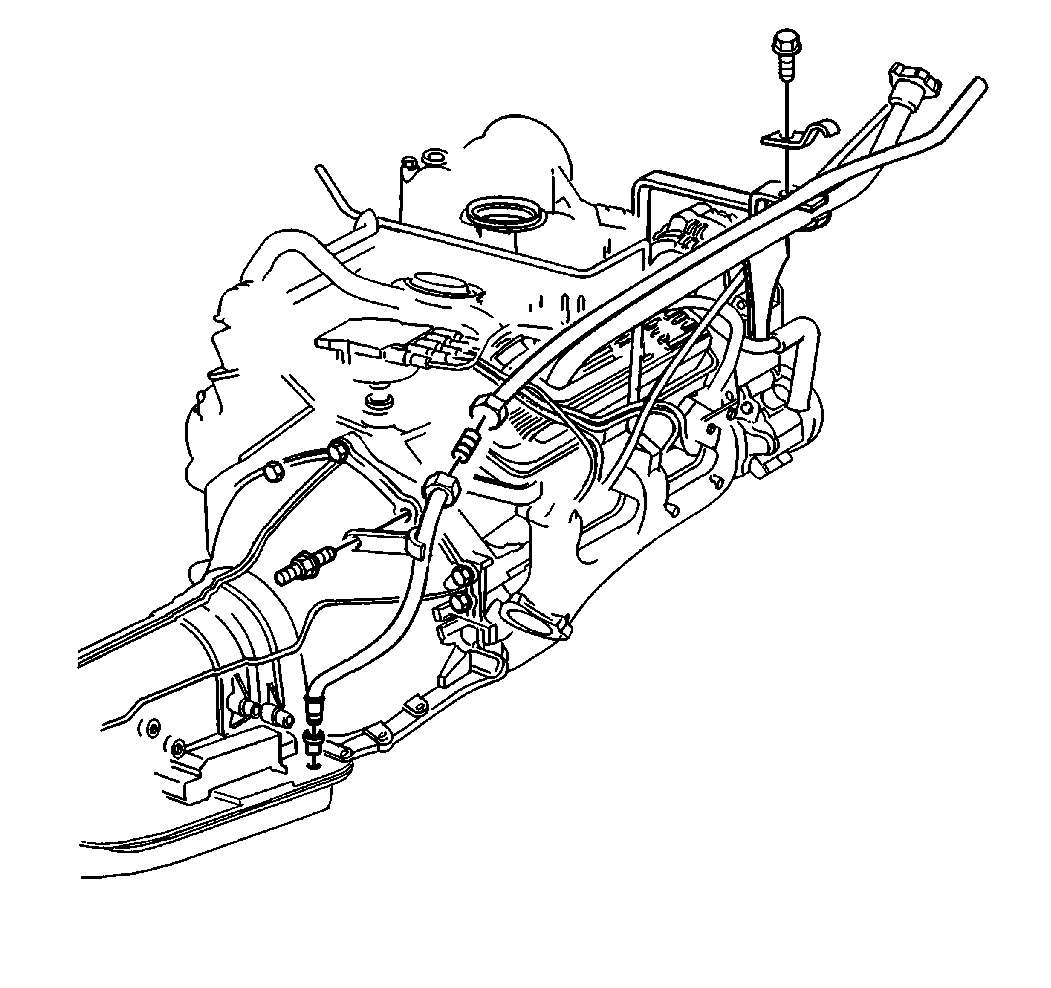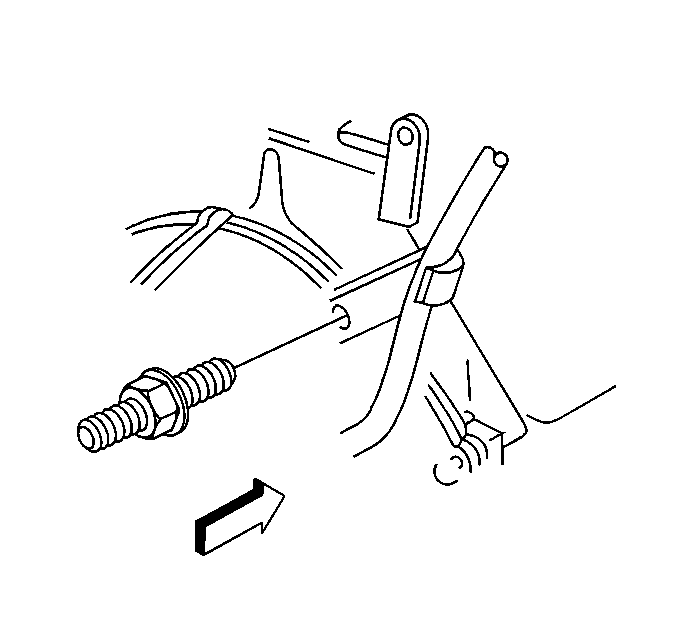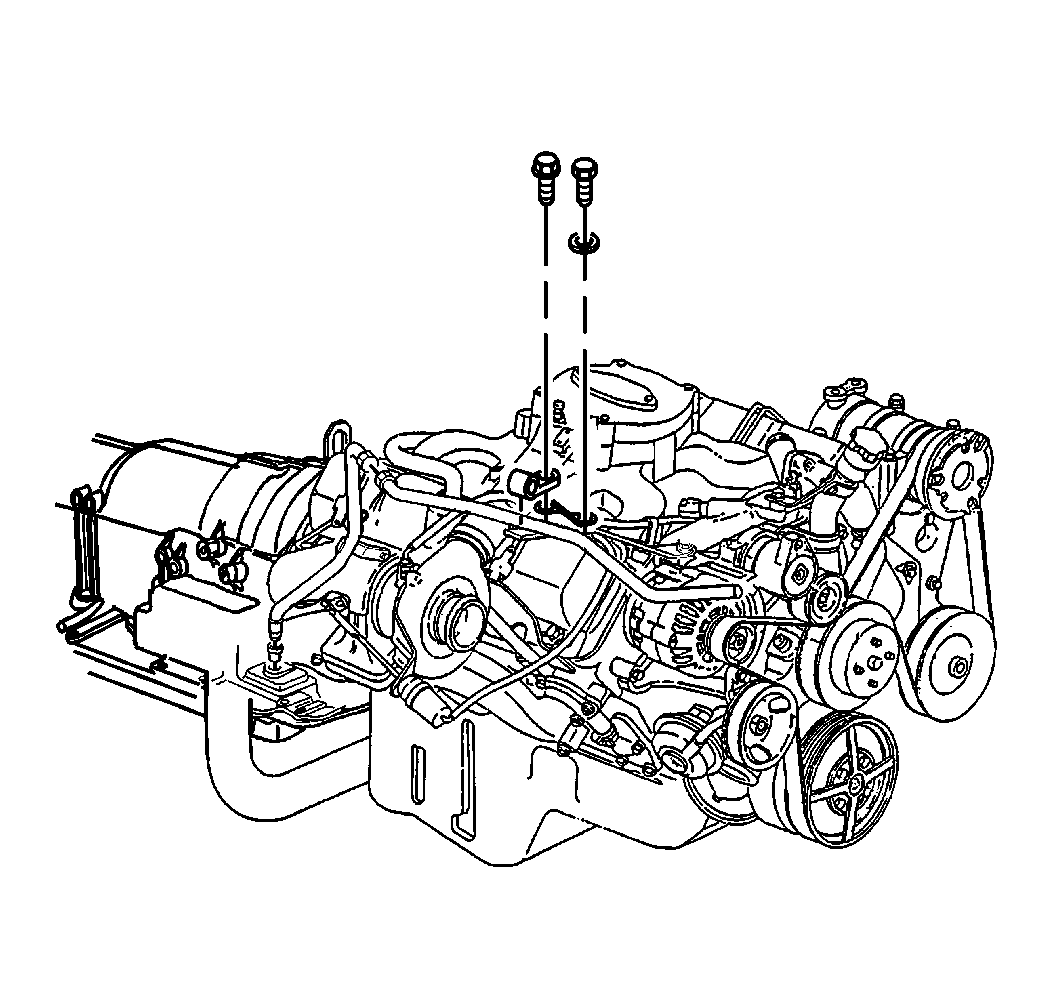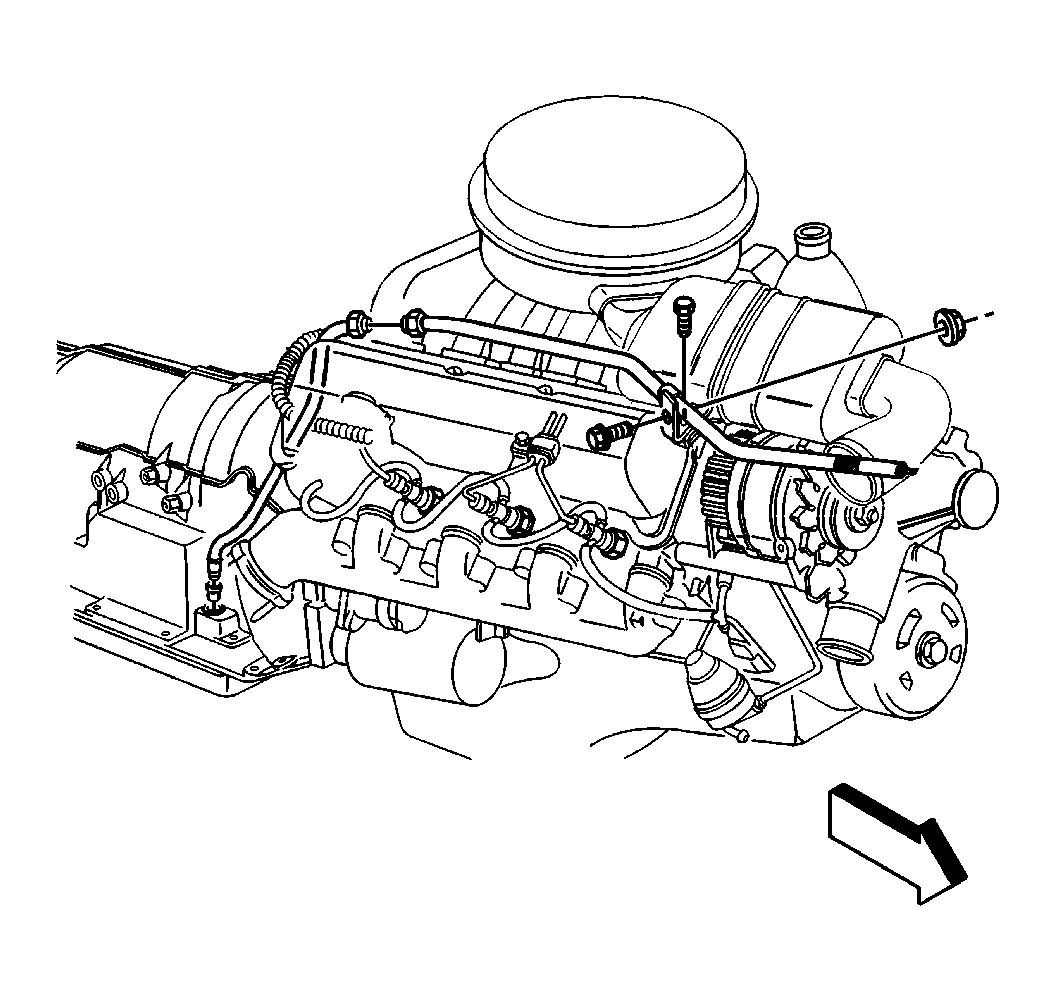Transmission Fluid Filler Tube and Seal Replacement L31/L35
Removal Procedure
- Remove the transmission oil lever indicator.
- Remove the transmission fluid fill tube to air outlet duct bracket bolt.
- Remove the transmission fluid fill tube stud from the transmission.
- Raise the vehicle.
- Remove the oil level indicator tube from the transmission.
- Remove the transmission fluid fill tube seal from the transmission case.

Installation Procedure
- Install the transmission fluid fill tube seal into the transmission case.
- Install the transmission fluid fill tube into the transmission case.
- Install the transmission fluid fill tube bracket stud to the transmission.
- Lower the vehicle.
- Install the transmission fluid fill tube to air outlet duct bracket bolt.
- Install the transmission oil level indicator.

Notice: Use the correct fastener in the correct location. Replacement fasteners must be the correct part number for that application. Fasteners requiring replacement or fasteners requiring the use of thread locking compound or sealant are identified in the service procedure. Do not use paints, lubricants, or corrosion inhibitors on fasteners or fastener joint surfaces unless specified. These coatings affect fastener torque and joint clamping force and may damage the fastener. Use the correct tightening sequence and specifications when installing fasteners in order to avoid damage to parts and systems.
Tighten
Tighten the stud to 50 N·m (37 lb ft).
Important: When re-connecting the upper and lower transmission fluid fill tubes, align the white dots (dimples) on the upper and lower transmission fluid fill tubes and re-torque the nuts to 28 N·m (21 lb ft).
Tighten
Tighten the bolt to 25 N·m (18 lb ft).
Transmission Fluid Filler Tube and Seal Replacement 7.4L
Removal Procedure
- Remove the transmission oil lever indicator.
- Remove the air inlet duct.
- Remove the transmission fluid fill tube to generator mounting bracket bolt.
- Raise the vehicle. Refer to Lifting and Jacking the Vehicle in General Information.
- Remove the transmission fluid fill tube bracket to transmission stud.
- Remove the transmission fluid fill tube.
- Remove the seal from the transmission fluid fill tube.

Installation Procedure
- Install the new seal into the transmission case.
- Install the transmission fluid fill tube into the transmission case.
- Install the transmission fluid fill tube bracket to transmission stud.
- Lower the vehicle.
- Install the transmission fluid fill tube to generator mounting bracket bolt.
- Install the air inlet duct.
- Install the transmission oil level indicator.

Notice: Use the correct fastener in the correct location. Replacement fasteners must be the correct part number for that application. Fasteners requiring replacement or fasteners requiring the use of thread locking compound or sealant are identified in the service procedure. Do not use paints, lubricants, or corrosion inhibitors on fasteners or fastener joint surfaces unless specified. These coatings affect fastener torque and joint clamping force and may damage the fastener. Use the correct tightening sequence and specifications when installing fasteners in order to avoid damage to parts and systems.
Tighten
Tighten the stud to 50 N·m (37 lb ft).
Important: When re-connecting the upper and lower transmission fluid fill tube, align the white dots (dimples) on the upper and lower transmission fluid fill tubes and re-torque the nuts to 28 N·m (21 lb ft).
Tighten
Tighten the bolt to 25 N·m (18 lb ft).
Transmission Fluid Filler Tube and Seal Replacement L65
Removal Procedure
- Remove the transmission oil lever indicator.
- Remove the transmission fluid fill tube bolts and washers from the turbocharger.
- Raise the vehicle.
- Remove the transmission fluid fill tube bracket to transmission stud.
- Remove the transmission fluid fill tube from the transmission case.
- Remove the transmission fluid fill tube seal from the transmission case.

Installation Procedure
- Install a NEW transmission fluid fill seal into the transmission case.
- Install the transmission fluid fill tube into the transmission case.
- Install the transmission fluid fill tube bracket to transmission stud.
- Lower the vehicle.
- Install the transmission fluid fill tube bolts and washers to the turbocharger.
- Install the transmission oil level indicator.

Notice: Use the correct fastener in the correct location. Replacement fasteners must be the correct part number for that application. Fasteners requiring replacement or fasteners requiring the use of thread locking compound or sealant are identified in the service procedure. Do not use paints, lubricants, or corrosion inhibitors on fasteners or fastener joint surfaces unless specified. These coatings affect fastener torque and joint clamping force and may damage the fastener. Use the correct tightening sequence and specifications when installing fasteners in order to avoid damage to parts and systems.
Tighten
Tighten the stud to 50 N·m (37 lb ft).
Important: When the transmission fluid fill tubes are separated for service, the following must be done to re-connect the upper and lower tubes. Align the white dots (dimples) on the upper and lower tubes and re-torque the nuts to 28 N·m (21 lb ft).
Tighten
Tighten the bolts to 25 N·m (18 lb ft).
Transmission Fluid Filler Tube and Seal Replacement L57
Removal Procedure
- Remove the transmission oil lever indicator.
- Remove the transmission fluid fill tube to air cleaner bracket bolt and nut.
- Raise the vehicle. Refer to Lifting and Jacking the Vehicle in General Information
- Remove the transmission fluid fill tube bracket stud from the transmission.
- Remove the transmission fluid fill tube from the transmission.
- Remove the transmission fluid fill tube seal from the transmission case.

Installation Procedure
- Install the NEW transmission fluid fill tube seal into the transmission case.
- Install the transmission fluid fill tube into the transmission case.
- Install the transmission fluid fill tube bracket stud to the transmission.
- Lower the vehicle.
- Install the transmission fluid fill tube to air cleaner bracket bolt and nut.
- Install the transmission oil level indicator.

Notice: Use the correct fastener in the correct location. Replacement fasteners must be the correct part number for that application. Fasteners requiring replacement or fasteners requiring the use of thread locking compound or sealant are identified in the service procedure. Do not use paints, lubricants, or corrosion inhibitors on fasteners or fastener joint surfaces unless specified. These coatings affect fastener torque and joint clamping force and may damage the fastener. Use the correct tightening sequence and specifications when installing fasteners in order to avoid damage to parts and systems.
Tighten
Tighten the stud to 50 N·m (37 lb ft).
Important: When re-connecting the upper and lower transmission fluid fill tubes, align the white dots (dimples) on the upper and lower tubes and re-torque the nuts to 28 N·m (21 lb ft).
Tighten
Tighten the to nut to 12 N·m (106 lb in).
